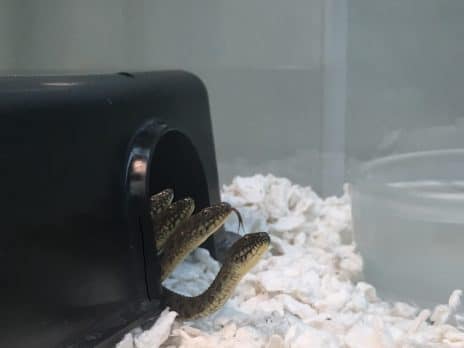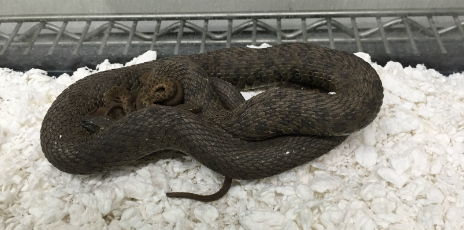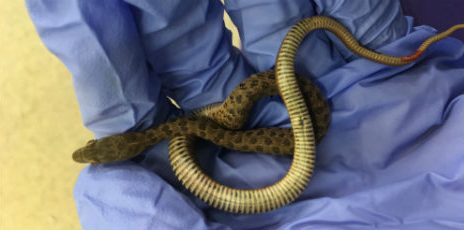Gartersnake Research Project in the News
- Gartersnake Video
News & Events
NAU student researchers contribute to discovery of emerging snake pathogen in Arizona
Here is a sample of reporter Heidi Toth’s article about some of our important research…
NAU Giving Day Donors Help Gartersnakes!

As a result of a challenge by Stephen and Mindy Saunders, on and around May 1 gartersnake research supporters raised funds to create mini-vivaria to house juvenile snakes.
These semi-outdoor naturalistic enclosures will help the juveniles acclimate to outdoor conditions, as a necessary part of preparing them for eventual release into the wild. Funds raised will also help improve indoor living conditions, by allowing us to modify existing tanks so that the snakes will be able to hunt fish at will. This will minimize the need for repeated handling of the snakes, and will save our student care-givers time.
Thank you so much to all of our generous gartersnake supporters!
NAU Giving Day: May 1st, 2019 – Native Gartersnake Research Challenge
Support research of native gartersnakes by donating to the Organismal Biology Research Fund. Research biologists and students are raising baby narrow-headed gartersnakes in an attempt to restore this federally threatened species to the wild. We hope to construct additional small vivaria to acclimate baby snakes to outdoor conditions. Once 5 gifts are received a generous donor will release a $1,000 gift to this fund.
by donating to the Organismal Biology Research Fund. Research biologists and students are raising baby narrow-headed gartersnakes in an attempt to restore this federally threatened species to the wild. We hope to construct additional small vivaria to acclimate baby snakes to outdoor conditions. Once 5 gifts are received a generous donor will release a $1,000 gift to this fund.
2019 REAP Funding Award
Sara Jarvis (PI) and co-investigators J.J. Duke, Tinna Traustadóttir, and Erika Nowak received funding for a Terason uSmart 3300 NexGen Ultrasound instrument to use in four different labs. Two of the labs (Jarvis and Traustadóttir) will use the ultrasound machine for a protocol called flow mediated vasodilation that assesses endothelial function (e.g., the health of the vasculature). The Duke lab will use it to obtain images of the heart to detect the presence of anatomical features such as the patent foramen ovale. The Nowak lab will use the system for capture of high quality 2-D images to assess several health outcome measures in reptiles such as reproductive health and pregnancy status, as well as injury status.

Notes from the Vivarium: Babies are born!
Eleven narrow-headed gartersnake babies were born in the vivarium on July 16, 2017 to captive Oak Creek female 071! This female and the babies’ father(s) – male 3/4L-1R, 4L-6R, and/or “Scar” were brought into captivity at NAU as juveniles in 2014 following the Slide Fire in Oak Creek. Mating occurred last fall before the adults entered the vivarium, and again in May 2017. Female gartersnakes can store sperm and one litter can have multiple paternity. We are waiting until the babies are a little bigger to complete paternity tests.
Hats off and huge thanks to interns Luke Jarrin and Cassidy Klovanish for finding most of the babies in the vivarium, and for so capably getting them set up indoors in the days following their birth. Thanks to Hannah Wilson and Kayla Lauger for helping them find the rest of the litter and getting the nursery fully organized!
We typically keep mom and babies together for a couple of days after birth to encourage kin recognition and normal social relationships. Now 071 is back out in the vivarium getting ready for hibernation, while the babies will remain indoors through next spring to make sure they are all eating and growing (this is called “headstarting”). Graduate student Kayla Lauger plans to investigate seasonal and husbandry-related changes in stress levels and reproductive hormones in the babies and adults by using a novel, non-invasive technique to measure cortisol levels in their shed skins. Over the winter, we will work with state and federal agencies to determine the best disposition for these important new arrivals.

The baby pictured above was named”#1” because it was the first one found in the vivarium. The red paint near the tail, is a visual identifier for us. We paint unique color combinations on the underside of the tail using non-toxic paint pens so that we can easily identify individuals.
Recent events
Museum of Northern Arizona Future of the Colorado Plateau Forum
Dr. Erika Nowak and collaborator Sharon Masek Lopez, executive director of the Oak Creek Watershed Council, presented information about the biology, status, and recovery progress of the narrow-headed gartersnake on the April 26th, 2017 forum at the Museum of Northern Arizona titled The Way Home: Species Recovery in the Grand Canyon Region.
The Future of the Colorado Plateau Forum is a series that provides an opportunity for the community to engage directly with the region’s decision-makers and opinion leaders on issues issues impacting the environmental, social, and economic future of the Colorado Plateau, one of North America’s most geographically and culturally diverse regions.
Articles of note
Oak Creek Habitat nearly recovered from Slide Fire (Arizona Daily Sun news article by Emery Cowan)
Excerpt: When the Slide Fire broke out at the edge of Oak Creek in May 2014, many people’s first thought was that the flames would turn the vibrant canyon and creek into a sterile wasteland.
Two years later though, officials familiar with the area say it continues to recover remarkably well. Negative long-term effects on aquatic life and water quality haven’t come to pass and the canyon vegetation has bounced back to the point that erosion, runoff and flooding concerns have dropped to levels comparable to before the fire, forest, weather and wildlife experts said.
“The watershed is still recovering but we’re well on our way to see that post-fire recovery,” said said Amina Sena, hydrologist on the Red Rock Ranger District, which encompasses Oak Creek Canyon.
Key to recovery has been the fact that over the past two years, the burn area has avoided heavy monsoon rains that would have caused severe flooding, said Marie McCormick, executive director of the Oak Creek Watershed Council. Instead, moderate moisture boosted new plant growth leading to excellent recovery, said Rory Steinke, retired Forest Service soil scientist who led the agency’s Burned Area Emergency Response (BAER) team on the Slide Fire.
Grass, ground cover and shrubs within the burn scar have regrown to the point that their ability to prevent accelerated erosion and runoff is nearly the same as before the fire, he said. That means flood risk and threat to the creek’s water quality has been substantially reduced, he said. Also good news is that soils have lost their hydrophobic crust so water infiltration into the ground is similar to prefire conditions, Steinke wrote in an email.
The recovery looked so good last spring that the Forest Service decided against doing another monitoring assessment of the area this year, Steinke said…(continue reading)
